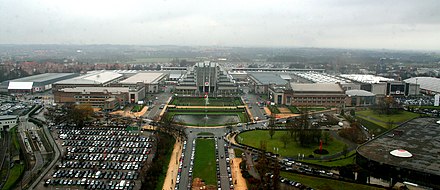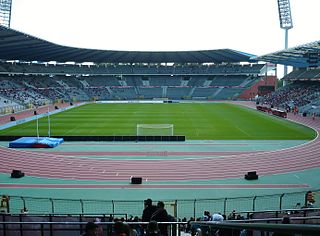
The King Baudouin Stadium is a sports ground in Brussels, Belgium. Located in the north-western district of the City of Brussels, it was built to embellish the Heysel/Heizel Plateau in view of the 1935 Brussels International Exposition. It was inaugurated on 23 August 1930, with Crown Prince Leopold attending the opening ceremony. The stadium hosted 70,000 at the time. Its name honours King Baudouin, Leopold's successor as King of the Belgians from 1951 to his death in 1993.
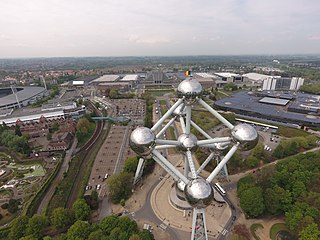
The Heysel Plateau or Heysel Park, usually shortened to Heysel or Heizel, is a neighbourhood, park and exhibition space in Laeken, northern Brussels, Belgium, where the Brussels International Exposition of 1935 and the 1958 Brussels World's Fair took place.

Laeken or Laken is a residential suburb in the north-western part of the Brussels-Capital Region, Belgium. It belongs to the municipality of the City of Brussels and is mostly identified by the Belgian postal code: 1020. Prior to 1921, it was a separate municipality.
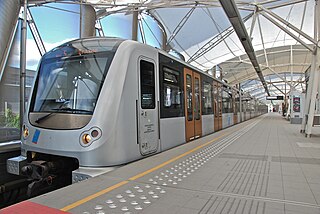
The Brussels Metro is a rapid transit system serving a large part of the Brussels-Capital Region of Belgium. It consists of four conventional metro lines and three premetro lines. The metro-grade lines are M1, M2, M5, and M6 with some shared sections, covering a total of 39.9 kilometres (24.8 mi), with 59 metro-only stations. The premetro network consists of three tram lines that partly travel over underground sections that were intended to be eventually converted into metro lines. Underground stations in the premetro network use the same design as metro stations. A few short underground tramway sections exist, so there is a total of 52.0 kilometres (32.3 mi) of underground metro and tram network. There are a total of 69 metro and premetro stations as of 2011.

The Brussels tramway network is a tram system serving a large part of the Brussels-Capital Region of Belgium. It is the 16th largest tram system in the world by route length, in 2017 providing 149.1 million journeys over routes 140.6 km (87.4 mi) in length. In 2018, it consisted of 18 tram lines. Brussels trams are operated by STIB/MIVB, the local public transport company.

King Baudouin is a Brussels Metro station and the western terminus of line 6. It is located in Laeken, in the north-west of the City of Brussels, Belgium, and serves the King Baudouin Stadium. It opened on 25 August 1998.

The 1996 UEFA Cup Winners' Cup final was a football match contested between Paris Saint-Germain of France and Rapid Wien of Austria. It was the final match of the 1995–96 UEFA Cup Winners' Cup and the 36th Cup Winners' Cup final. The final was held at King Baudouin Stadium in Brussels on 8 May 1996, hosting its first European club final since the scenes of the Heysel Stadium disaster eleven years prior. Paris Saint-Germain won the match 1–0, thanks to a free kick from Bruno Ngotty.

Bockstael is a Brussels Metro station on line 6. It opened on 6 October 1982 and is named after the Place Émile Bockstael/Émile Bockstaelplein in Laeken, in the north-west of the City of Brussels, Belgium, where it is located. Prior to the opening of the extension to Heizel/Heysel metro station in 1985, the station was the western terminus of former line 1A.
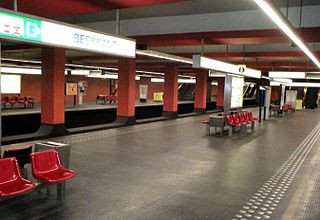
Beekkant is a Brussels Metro station located in the municipality of Molenbeek-Saint-Jean, in the western part of Brussels, Belgium. It opened on 8 May 1981 as part of the Sainte-Catherine/Sint-Katelijne–Beekkant extension of former line 1, and was for a year, until 6 October 1982, the western terminus of the metro. Then, following the reorganisation of the Brussels Metro on 4 April 2009, it is served by lines 1, 2, 5 and 6.
The Brussels tram route 23 was a Brussels tram route operated by STIB/MIVB in Brussels, Belgium. It ran between Vanderkindere, which was also the terminus for tram route 24 and where passengers could commute with tram routes 3, 4 and 92, and the Heysel/Heizel metro station, which offers transit with the Brussels metro line 6, tram route 51 and bus routes 84 and 88. Since March 14, 2011 the newly formed tram 7 follows the same route as tram 23, but with a much higher frequency. Because of the frequency being brought up to 'metro' level, its line number was altered to the lower regions, for those are the metro and so-called 'Chrono' tramlines. Tram 24 was also taken over completely by the newly formed tram 7.
Heysel or Heizel is an area in Brussels and may in particular refer to:

Tram route 81 in Brussels, Belgium, is a tram route operated by STIB/MIVB, which connects the Marius Renard stop in the municipality of Anderlecht with the multimodal Montgomery metro station in Woluwe-Saint-Pierre. The route also crosses the municipalities of Saint-Gilles, Ixelles, the City of Brussels and Etterbeek. It connects with the Metro at Saint-Guidon/Sint Guido, Brussels-South, Merode and Montgomery. The route also crosses the major tram routes 3 and 4 at Horta. A good deal of its length is in carriageway, while long sections at either end are in reservation. It has a short section in tunnel at Brussels-South.

The tram route 51 in Brussels, Belgium, is a tram route operated by STIB/MIVB, which connects Heysel/Heizel metro station in the City of Brussels to the Van Haelen stop in the municipality of Uccle. The route runs north–south, crossing the City of Brussels, Jette, Molenbeek-Saint-Jean, the City of Brussels again, Saint-Gilles, Forest and Uccle. Currently, service is interrupted between Brussels-South railway station and Altitude Cent/Hoogte Honderd due to construction work at Albert premetro station.

Line 5 on the Brussels Metro is a rapid transit line operated by STIB/MIVB, which connects Herrmann-Debroux at the south-east of Brussels to Erasme/Erasmus at the south-west via the city centre. It exists in its current form since April 4, 2009, when the section of former line 1A between Beekkant and King Baudouin was replaced by the section of former line 1B between Beekkant and Erasme. Starting from Herrmann-Debroux, the line crosses the municipalities of Auderghem, Etterbeek, City of Brussels, Molenbeek-Saint-Jean, Koekelberg and Anderlecht. It serves 28 metro stations and has a common section with line 1 between Gare de l'Ouest/Weststation and Mérode station, and with lines 2 and 6 between West station and Beekkant. At Arts-Loi/Kunst-Wet the line also connects with lines 2 and 6. Railway connections are possible at Brussels-Central railway station, Schuman station, Mérode and West station.
The 1998–99 Belgian Cup was the 44th season of the main knockout competition in Belgian association football, the Belgian Cup.

The premetro and tram route 7 in Brussels, Belgium, is a tram route operated by STIB/MIVB, which connects the Vanderkindere stop in the southern municipality of Uccle with the Heizel/Heysel stop in Laeken in the City of Brussels, where connecting services of tram route 51, Metro line 6, as well as bus routes 84 and 88 depart. The colour of the signage for this line is bright yellow.
Throughout their history, the Belgium national team have played at 24 home locations in 12 urban areas, most often in the country's Capital Region, Brussels. The national King Baudouin Stadium, with a capacity of 50,024 people, is the usual playing ground nowadays. At this location, the majority of the Red Devils' home matches took place. Other stadiums are normally assigned as home ground in case a rather small audience is to be expected or when the national stadium is in repair.

The ING Arena is an indoor arena in Brussels, Belgium, that is part of the Brussels Expo complex. Located on the Heysel/Heizel Plateau in Laeken, it was originally built as the twelfth hall of the complex in 1989, but was extensively redesigned and reopened in its current form in September 2013. Until 14 September 2023, the arena was known as the Palais 12 in French or Paleis 12 in Dutch. It now hosts major events, such as concerts, conferences, entertainment shows and major sporting events for a maximum capacity of 15,000 people.
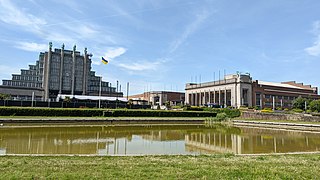
The Brussels Exhibition Centre, also known as Brussels Expo, is the most important event complex in Brussels, Belgium. Located on the Heysel/Heizel Plateau in Laeken, the twelve halls that comprise it are used for the largest national and international trade fairs, exhibitions and other events. With 115,000 m2 (1,240,000 sq ft) of facility space, they constitute the largest exhibition space in the Benelux. They are also a remarkable witness to the evolution of construction techniques during the 20th century.

